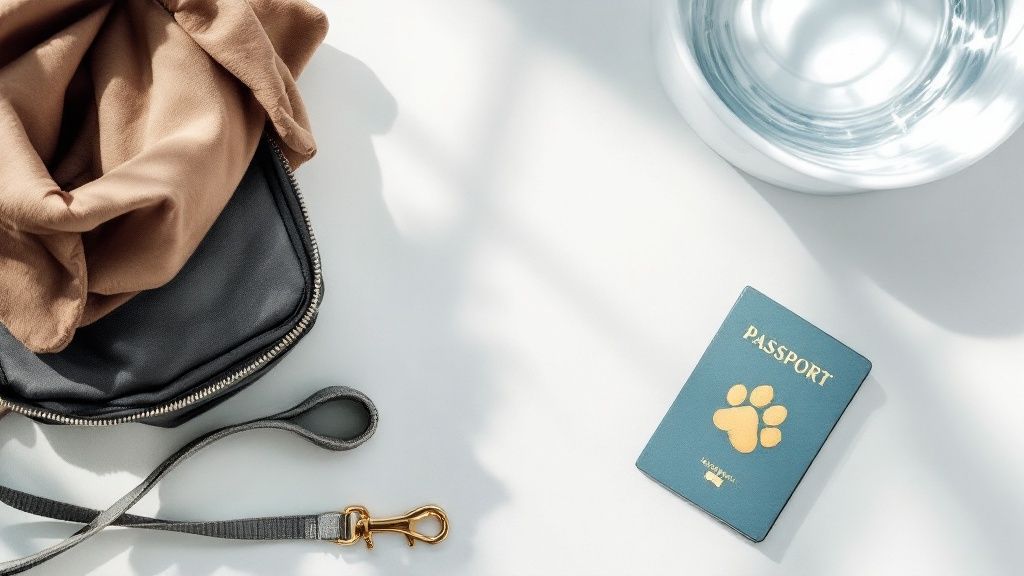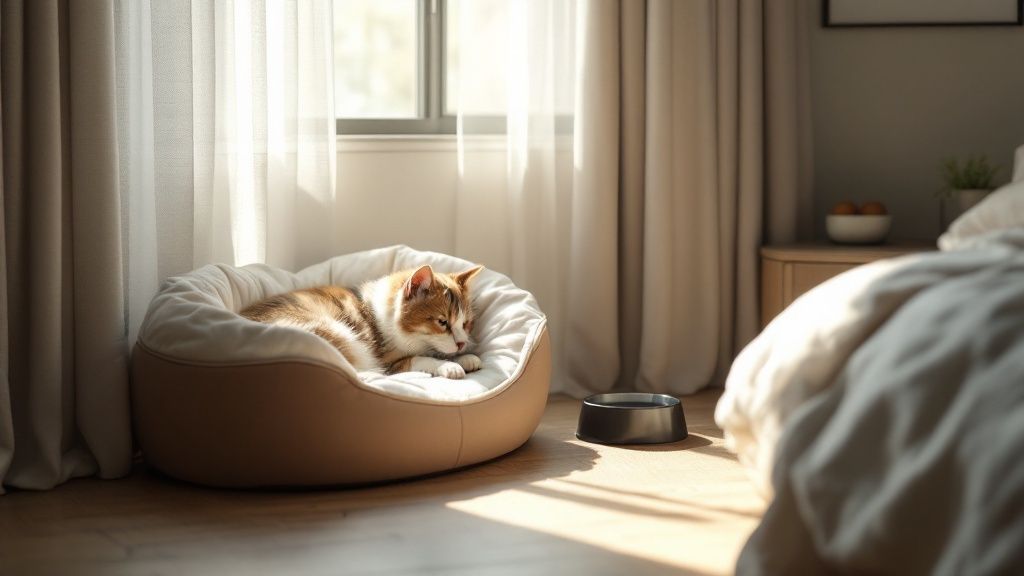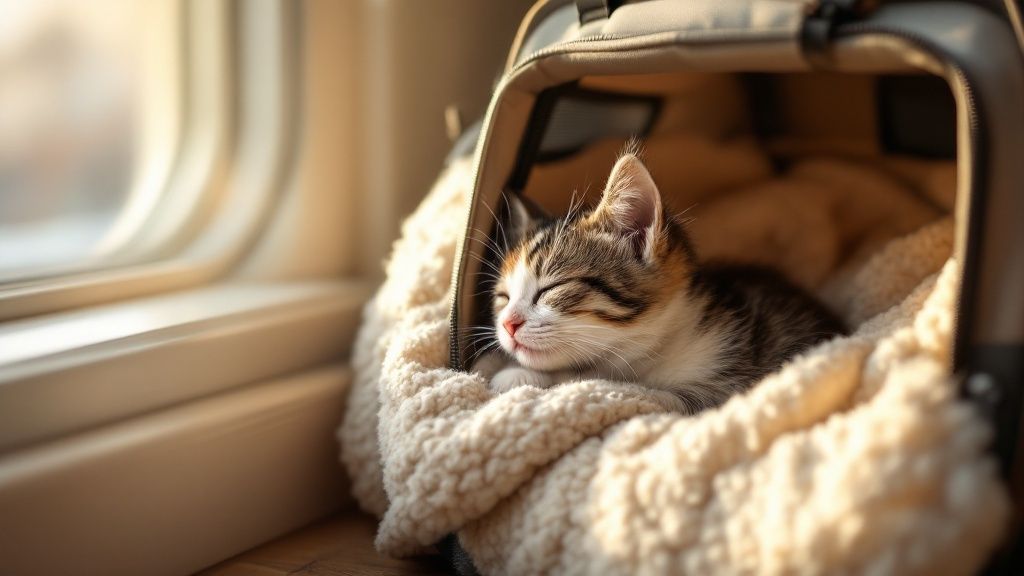How to Travel with Pets: Your Guide to Stress-Free Journeys
- The Muse Hotel
- Sep 7
- 14 min read
Updated: Sep 11
Taking your pet along on a trip isn't just a matter of packing them in the car—a little forethought goes a long way. The real secret to a smooth journey is handling the important stuff before you leave. We're talking about a quick vet check-up, getting all your paperwork sorted, and packing a special bag just for them. For those planning a stylish getaway, finding a truly pet-welcoming spot like [The Muse Hotel Palm Springs](https://www.themusehotelpalmsprings.com/) can transform a good trip into a great one. Nail these basics, and you're setting yourself up for an amazing adventure with your furry co-pilot.
TL;DR – Key Takeaways for Pet-Friendly Travel
Plan Ahead: Schedule a vet visit 1-2 months before your trip for a health check and to get necessary paperwork, like a health certificate (CVI).
Pack Smart: Bring a dedicated kit with their food, water, medications, and comfort items like a favorite blanket to ease anxiety.
Travel Safely: Use a crash-tested carrier or safety harness in the car and choose an airline-approved carrier for flights. Never leave them unrestrained.
Choose Accommodations Wisely: Look for hotels with practical pet amenities like green spaces. For a truly seamless group trip with pets, a private hotel buyout can be a perfect solution.
🌟 Spotlight on The Muse Hotel Palm Springs ✔ Adults-only, private & peaceful ✔ Hot tub + floral pergola courtyard ✔ Stylish mid-century aesthetic ✔ Kitchenettes & patios in every suite ✔ Ideal for groups & full buyouts 👉 [Check it out](https://www.themusehotelpalmsprings.com)
Your Pre-Trip Pet Travel Planning Guide

The best adventures start with a solid plan, especially when your co-pilot has four paws and a tail. And you're not alone in this—traveling with pets has become a huge part of modern life.
Believe it or not, around 78% of American pet owners hit the road with their pets every year. It’s clear our pets are family, and we want to share the world with them. If you're curious, you can dive into more pet travel statistics and see just how common these journeys have become.
Before you get lost in booking flights or mapping out your road trip, your very first stop should be the vet's office. Think of this as a strategic mission briefing to make sure your pet is truly ready for the journey ahead.
Assess Your Pet's Fitness for Travel
Let’s be honest: not every pet is cut out for the nomadic life. You have to take a serious look at your pet's age, health, and personality. A senior dog with arthritis probably won’t thank you for a 12-hour car ride, and an anxious cat might find a bustling airport completely overwhelming.
Your vet is your best resource here. They can give you a professional take on whether your pet can handle the stress of a new place and your chosen mode of travel. Plus, they can screen for any underlying health issues that could flare up on the road.
Key Takeaway: That pre-travel vet visit isn't just a suggestion—it's the first step of responsible pet ownership. It confirms your pet is healthy enough for the trip and gets you the medical clearances you'll need.
Compile All Necessary Paperwork
Having the right documentation is a total non-negotiable, whether you're just crossing state lines or heading overseas. The first thing to check is that your pet’s microchip information is current with your phone number and address. If your pet ever gets lost, that tiny chip is their ticket home.
Next up, get your document folder ready with these essentials:
Vaccination Records: Make sure everything is up to date, especially the rabies vaccine.
Health Certificate: Many airlines and some states require a Certificate of Veterinary Inspection (CVI). These are time-sensitive and usually need to be issued within 10-30 days of your travel date.
International Requirements: Flying abroad? Start your research early. Every country has its own rules, which can include specific blood tests, parasite treatments, or even mandatory quarantine periods.
Pack a Dedicated Pet Travel Kit
Packing a bag just for your pet is one of the best things you can do to keep them comfortable. Having their own familiar gear helps ease anxiety and keeps their routine feeling as normal as possible, even in a strange new place.
Here’s what should be in their go-bag:
Food and Water: Pack more food than you think you’ll need to cover any unexpected delays. Portable, collapsible bowls are a lifesaver.
Medications: Keep all meds in their original bottles with the labels clearly visible.
Comfort Items: Their favorite blanket, bed, or a well-loved squeaky toy can make an unfamiliar hotel room feel just like home.
Grooming and Cleanup Supplies: Pet wipes, poop bags, and a small brush are always good to have on hand.
To help you stay on track, we've put together a simple timeline. Planning ahead means less stress for everyone involved.
Pet Travel Preparation Timeline
Time Before Trip | Task | Key Considerations |
|---|---|---|
2-3 Months | Research Destination & Transportation Rules | Check airline pet policies, hotel pet fees, and any country-specific import requirements for international travel. |
1-2 Months | Schedule a Vet Visit | Discuss your travel plans, check on necessary vaccinations or medications, and ask about sedation options if needed. |
1 Month | Get the Required Health Certificate (CVI) | Most health certificates must be issued within 30 days of travel. Confirm the exact window required by your airline/destination. |
2-3 Weeks | Update Microchip & ID Tags | Ensure your contact information is current on both the microchip registration and the physical ID tag on their collar. |
1 Week | Pack the Pet Travel Kit | Gather food, water, bowls, medications, toys, bedding, and cleanup supplies. Don't forget copies of all paperwork. |
1-2 Days Before | Confirm All Reservations | Call the airline and hotel to re-confirm their pet policies and your pet's reservation to avoid any last-minute surprises. |
Day of Travel | Keep Your Pet Comfortable | Exercise your pet before leaving, limit food a few hours before departure, and keep them calm and secure in their carrier. |
Getting these planning steps handled early builds a solid foundation for a trip that’s not just fun, but safe and memorable for the whole family—two-legged and four-legged members included.
How to Navigate Air Travel with Your Pet

Flying with a pet can feel like the biggest hurdle in your trip planning, but I promise it's entirely manageable with a little know-how. The real key is to get ahead of the airline policies and do everything you can to make your companion safe and comfortable from check-in to landing.
It's a process more and more of us are getting familiar with. The global pet travel services industry was valued at around $2.4 billion in 2024 and is expected to more than double in the next ten years. That boom tells you everything you need to know—our pets are non-negotiable travel buddies now. You can explore the full market analysis on pet travel services to see just how much the industry is shifting to meet our demands.
In-Cabin vs. Cargo Travel
First things first: you have to figure out where on the plane your pet will be. Will they fly in the cabin with you, or will they travel as cargo? The answer almost always comes down to their size and weight.
In-Cabin: This is the best-case scenario for small pets who can fit comfortably in a carrier that slides under the seat in front of you. It's what most of us prefer because you can keep an eye on them, monitor their stress levels, and offer a little reassurance.
Cargo: For bigger dogs that are over the in-cabin weight and size limits, the only option is the temperature-controlled, pressurized cargo hold. Airlines have strict safety protocols for this, but let's be honest—it can be a much more stressful experience for some animals.
No matter which option you need, book your pet's spot on the flight the moment you book your own. Airlines strictly limit the number of animals allowed on each flight, and you absolutely cannot add them last minute.
Choosing the Right Carrier
Think of your pet's carrier as their personal little safety pod for the flight. It needs to be perfect. Airlines are notoriously picky about their requirements, and showing up with the wrong carrier is a surefire way to be denied boarding.
Look for a carrier that is:
Airline-Approved: Double-check your specific airline's size dimensions for under-seat carriers. I've found that soft-sided carriers are often the best bet for in-cabin travel because they have a little more give.
Well-Ventilated: Proper airflow is non-negotiable. Look for mesh panels on at least two or three sides to keep your pet comfortable and safe.
Secure: The zippers need locking clips to stop any furry escape artists mid-flight. The carrier has to be fully enclosed—no heads popping out!
Comfortable: It needs to be large enough for your pet to stand up and turn around inside. A pro tip is to line it with a familiar blanket or an old t-shirt of yours to make it smell and feel more like home.
Navigating the Airport and the Flight
On travel day, make sure your dog gets a good, long walk before you even think about heading to the airport. Once you get to security, you'll need to take your pet out of the carrier and carry them through the scanner with you while the empty carrier goes through the X-ray machine.
A Critical Vet-Approved Tip: Most veterinarians will strongly advise you not to sedate your pet for air travel. Sedatives can mess with their ability to regulate body temperature and balance, which is especially dangerous at high altitudes.
Instead of medication, I always focus on natural calming methods. Calming treats, a favorite toy, or a pheromone spray like Feliway for cats or Adaptil for dogs can work wonders. Keeping your pet secure and reassured is always the best way to guarantee a smooth flight for everyone.
Tips For A Smooth Road Trip With Pets

Hitting the open road with your pet is one of the best ways to travel, offering a freedom you just don't get with other modes of transport. But to make it a truly memorable journey for everyone, turning your car into a safe and happy space is the first and most important step.
The absolute number one rule for any pet-friendly road trip is making sure your companion is safely secured. An unrestrained pet isn't just a distraction; they can become a serious hazard in a sudden stop. Thankfully, there are some great, crash-tested options to keep them safe and sound.
Carriers and Crates: These are often the safest bet, especially for smaller dogs and cats. A well-secured crate gives them a cozy, den-like space and prevents them from interfering with your driving.
Safety Harnesses: If your dog loves to watch the world go by, a proper vehicle safety harness is the way to go. These clip directly into the seatbelt system and are a fantastic alternative to a crate.
Booster Seats: For the little guys, a booster seat that straps securely around your car’s seat gives them a great view while keeping them safely contained.
Planning Your Pet-Friendly Route
A great road trip is about the journey, not just the destination. When you have a furry co-pilot, that means building plenty of breaks into your schedule. A good rule of thumb is to stop every 2-3 hours. This gives your pet a chance to stretch, go to the bathroom, and have a drink of water.
Before you go, use your favorite map app to scope out parks, rest areas with grassy patches, or even short, pet-friendly walking trails along your route. These quick stops are perfect for breaking up the drive and keeping restlessness at bay. Planning a one-way adventure? If you're looking at a longer journey or just don't want to drive back, exploring one-way car rental options can give you the flexibility you need.
Motion sickness and anxiety can be a real issue for some pets. Cracking a window for fresh air, keeping the car cool, and offering a calming treat can help. It also works wonders to get them used to the car with a few short, fun drives before the big trip.
Your Car-Specific Packing List
Aside from the usual travel kit, a few car-specific items will make your life a whole lot easier on the road. Being prepared for spills, dirt, or a spontaneous hike means you can handle anything that comes your way.
Here’s what should be on your must-have list:
A non-spill water bowl for mess-free hydration on the move.
Durable seat covers or a hammock to protect your interior from fur, claws, and dirt.
A roll of paper towels and pet-safe cleaning spray for those inevitable accidents.
Extra leashes and poop bags stashed in the glove compartment for easy access at every stop.
With just a bit of prep, your road trip can be an incredible bonding experience. Speaking of amazing journeys, if your travels bring you to Southern California, you'll find some spectacular scenery to explore together. For some inspiration, check out our guide to the [10 best day trips from Palm Springs](https://www.themusehotelpalmsprings.com/post/10-best-day-trips-from-palm-springs-2025-guide) that you and your pup are sure to love.
Choosing Truly Pet-Friendly Accommodations in Palm Springs

Finding the perfect place to stay is a huge part of the fun, but the term "pet-friendly" can mean wildly different things. Some places simply tolerate pets, while others roll out the welcome mat. Your job is to find the latter, making sure your accommodation is a true home-away-from-home for every member of your group.
The label alone isn't enough. A hotel might allow pets but then stick you in a less-than-desirable room or have zero accessible green space for those necessary potty breaks. The key is to look beyond the policy and investigate the actual amenities and environment.
Digging Deeper Than "Pets Allowed"
Before you even think about booking, it’s time to play detective. A quick call or email to the property can save you from major headaches later. Arm yourself with a list of specific questions to understand what their pet policy truly entails.
Here are the essential questions to ask:
What are the pet fees? Are they per night, or a one-time cleaning fee? Hidden costs can add up fast.
Are there size or breed restrictions? This is a non-negotiable detail. Confirming it upfront saves you from the nightmare of being turned away at check-in.
Where are the designated relief areas? Is there a convenient, well-lit grassy spot, or will you be searching for a patch of green at midnight?
Can my pet be left unattended? Some hotels require your pet to be with you at all times, which can seriously cramp your style and derail your plans.
A truly pet-friendly hotel doesn't just allow pets; it anticipates their needs. Look for perks like welcome treats, dedicated water bowls, and easy access to outdoor spaces that make your stay seamless.
Helping Your Pet Settle In
Once you arrive, your first task is to make the new space feel familiar and safe. Don't just let your pet run wild immediately. Instead, create a designated "comfort corner" for them.
Set up their bed or crate, a few favorite toys, and their food and water bowls in one spot. This gives them a secure home base to retreat to if they feel overwhelmed. Sticking to their regular feeding and walking schedule as much as possible also provides a comforting sense of routine.
For those planning group getaways to sunny destinations like Palm Springs, finding a place that accommodates everyone—pets included—is the ultimate goal. For a truly seamless experience, a place like [The Muse Hotel Palm Springs](https://www.themusehotelpalmsprings.com/) offers exclusive buyouts, giving your entire group and your furry friends a stylish, private oasis with a secure courtyard to enjoy. You can find more inspiration in our guide to the [best Palm Springs pet-friendly hotels](https://www.themusehotelpalmsprings.com/post/your-guide-to-the-best-palm-springs-pet-friendly-hotels).
Keeping Your Pet Safe and Healthy on Your Trip
Let's be honest, your pet's well-being is the number one thing on your mind when you bring them on an adventure. The best way to make sure the trip is a blast for everyone is to be proactive. This starts with something simple: keeping their routine as normal as possible, especially when it comes to food.
Sudden changes in their diet or feeding times are a recipe for an upset stomach. To sidestep that drama, pack their regular food and stick to their usual meal schedule. And always, always make sure they have access to fresh, clean water. Dehydration can sneak up fast, particularly in a new place or a warmer climate.
Recognizing and Responding to Stress
Just like us, our pets can get overwhelmed by new sights, sounds, and smells. The key is learning to read their body language so you can step in before their anxiety gets the best of them.
Keep an eye out for these subtle signs:
Excessive panting or drooling (when they're not hot)
A tucked tail or a low, crouched posture
Whining, whimpering, or other unusual noises
Refusing to eat or drink
If you spot these behaviors, it's time for a timeout. Find a quiet spot where they can decompress. Sometimes all it takes is a short walk, a few tosses of their favorite toy, or just some calm, reassuring pets to help them feel safe again.
Taking our pets along for the ride is a huge trend, and it’s not going anywhere. Dogs lead the pack, making up a whopping 58% of all traveling pets globally. But this boom in furry travel companions highlights a real need for better solutions—a recent study found that 35% of owners actually cut their vacations short to accommodate their pets.
Preparing for the Unexpected
Even with the most careful planning, things can go wrong. Having a solid backup plan in place is the ultimate peace of mind. Before you even pack your own bags, put together a first-aid kit specifically for your pet.
Your kit should be stocked with essentials like antiseptic wipes, gauze, self-adhesive bandages, and your vet's emergency contact number. It's also smart to have both a physical and digital copy of their vaccination records handy.
Just in case a real emergency pops up, it’s a lifesaver to know where to find reliable emergency vet services near your destination before you leave home. A quick Google search for 24-hour animal hospitals in the area can save precious minutes when it counts. And for those looking to ensure their stay is as safe as it is comfortable, it's worth checking out our guide to luxury hotels that welcome pets for posh getaways.
To help you stay organized, here's a quick-reference table of the absolute essentials for any trip.
Pet Travel Safety Essentials
Safety Category | Essential Item/Action | Why It's Important |
|---|---|---|
Identification | Collar with ID tags, microchip | Ensures your pet can be identified and returned if they get lost. |
Health Records | Vaccination & health certificates | Required by many airlines and hotels; crucial in a medical emergency. |
First-Aid Kit | Bandages, antiseptic, vet's number | Allows you to handle minor injuries and be prepared for bigger issues. |
Hydration & Food | Regular food, portable water bowl | Prevents digestive upset and dehydration in unfamiliar environments. |
Emergency Plan | Research local vets ahead of time | Saves critical time and reduces stress during an unexpected emergency. |
Having these bases covered means you can spend less time worrying and more time making incredible memories with your four-legged best friend.
FAQ: Common Questions About Traveling with Pets
Even the most seasoned travelers have questions when bringing a furry friend along for the ride. Let's tackle some of the most common concerns to make sure you and your pet are ready for anything.
How do I help my anxious pet in a new place?
A new environment can be overwhelming, but a little preparation goes a long way. The key is to blend familiarity with patience. The moment you arrive, create a "safe zone" by setting up their bed, a favorite blanket that smells like home, and a familiar toy. Try to stick to their usual feeding and walking schedule as much as possible, as routines are incredibly comforting.
What makes a boutique hotel like The Muse Hotel good for pets?
Unlike larger resorts, boutique hotels often provide a quieter, more controlled environment, which can be less stressful for pets. The Muse Hotel Palm Springs, for instance, offers private patios with every suite and a secure, enclosed courtyard. This gives your pet safe outdoor space away from the hustle and bustle, making it feel more like a private hideaway.
Is The Muse Hotel Palm Springs adults-only?
Yes, The Muse is an adults-only (21+) hotel, creating a peaceful and relaxing atmosphere perfect for romantic getaways, bachelorette parties, and girls' trips. While it's a serene setting for human guests, their thoughtful layout also makes it a comfortable space for well-behaved pets to join the vacation.
Can I bring my pet on public transportation?
This is where things get tricky, as rules vary wildly. Many subways and buses in major cities allow small pets in carriers, but ride-sharing apps like Uber and Lyft leave it up to the driver. Always check the specific policies for the city you're visiting and call your driver to confirm they're okay with your pet joining the ride.
What are the basics of international pet travel?
International pet travel requires serious planning, often months in advance. Every country has its own strict rules, but you will generally need an ISO-compliant microchip, up-to-date vaccinations (especially rabies), and a country-specific veterinary health certificate endorsed by a government agency like the USDA. Start the process at least six months before your trip.
Whether you're planning a Palm Springs weekend getaway, a girls’ trip, or simply want a more stylish place to unwind, The Muse Hotel Palm Springs brings together privacy, design, and atmosphere in one beautifully curated package.

Comments